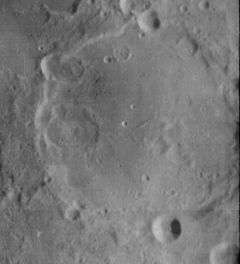Messala (crater)
|
Lunar Orbiter 4 image | |
| Coordinates | 39°12′N 59°54′E / 39.2°N 59.9°ECoordinates: 39°12′N 59°54′E / 39.2°N 59.9°E |
|---|---|
| Diameter | 125 km |
| Depth | 1.1 km |
| Colongitude | 313° at sunrise |
| Eponym | Messala |
Messala is a lunar crater of sufficient dimension to belong to the category of impact features known as walled plains. It is located in the northeastern part of the Moon, close enough to the rim to appear significantly foreshortened. Nearly attached to the northern rim is the crater Schumacher. To the southwest is the prominent crater Geminus, and due south is the smaller Bernoulli.
The outer rim of this formation has received a significant amount of erosion due to minor impacts, but much of the outer wall retains its original shape and a certain degree of terracing. The rim is broken by smaller craters along the south, north, and northwest sides, designated Messala B, J, and K, respectively. Messala J has a narrow gouge in its eastern rim leading one crater diameter to the east. It is attached to a slightly larger crater which lies across the southern rim of Schumacher.
The interior floor is relatively level but contains irregularities in the surface at some locations. There are several small craters across the floor, which are now little more than low rims and depressions in the surface. The most notable of these is a ghost crater along the western inner wall.
Origin of name
The crater is named after Masha'allah ibn Atharī (c.740-d.815 AD), a Persian Jewish astrologer and astronomer from the city of Basra (now located in modern-day Iraq) who was the leading astrologer of the late 8th century. Masha'allah was one of the most prominent members of the commission which decided the Caliph al-Mansur (A.D. 754-775) that the propitious moment for the founding of Baghdad fell on 30 July 762.
Satellite craters
By convention these features are identified on lunar maps by placing the letter on the side of the crater midpoint that is closest to Messala.
| Messala | Latitude | Longitude | Diameter |
|---|---|---|---|
| A | 36.6° N | 53.8° E | 26 km |
| B | 37.4° N | 59.9° E | 18 km |
| C | 40.9° N | 65.8° E | 12 km |
| D | 40.5° N | 67.8° E | 28 km |
| E | 40.0° N | 64.9° E | 40 km |
| F | 38.9° N | 64.4° E | 32 km |
| G | 39.1° N | 68.6° E | 29 km |
| J | 41.1° N | 61.2° E | 15 km |
| K | 41.1° N | 58.5° E | 13 km |
References
- Andersson, L. E.; Whitaker, E. A. (1982). NASA Catalogue of Lunar Nomenclature. NASA RP-1097.
- Blue, Jennifer (July 25, 2007). "Gazetteer of Planetary Nomenclature". USGS. Retrieved 2007-08-05.
- Bussey, B.; Spudis, P. (2004). The Clementine Atlas of the Moon. New York: Cambridge University Press. ISBN 978-0-521-81528-4.
- Cocks, Elijah E.; Cocks, Josiah C. (1995). Who's Who on the Moon: A Biographical Dictionary of Lunar Nomenclature. Tudor Publishers. ISBN 978-0-936389-27-1.
- McDowell, Jonathan (July 15, 2007). "Lunar Nomenclature". Jonathan's Space Report. Retrieved 2007-10-24.
- Menzel, D. H.; Minnaert, M.; Levin, B.; Dollfus, A.; Bell, B. (1971). "Report on Lunar Nomenclature by the Working Group of Commission 17 of the IAU". Space Science Reviews. 12 (2): 136–186. Bibcode:1971SSRv...12..136M. doi:10.1007/BF00171763.
- Moore, Patrick (2001). On the Moon. Sterling Publishing Co. ISBN 978-0-304-35469-6.
- Price, Fred W. (1988). The Moon Observer's Handbook. Cambridge University Press. ISBN 978-0-521-33500-3.
- Rükl, Antonín (1990). Atlas of the Moon. Kalmbach Books. ISBN 978-0-913135-17-4.
- Webb, Rev. T. W. (1962). Celestial Objects for Common Telescopes (6th revised ed.). Dover. ISBN 978-0-486-20917-3.
- Whitaker, Ewen A. (1999). Mapping and Naming the Moon. Cambridge University Press. ISBN 978-0-521-62248-6.
- Wlasuk, Peter T. (2000). Observing the Moon. Springer. ISBN 978-1-85233-193-1.
